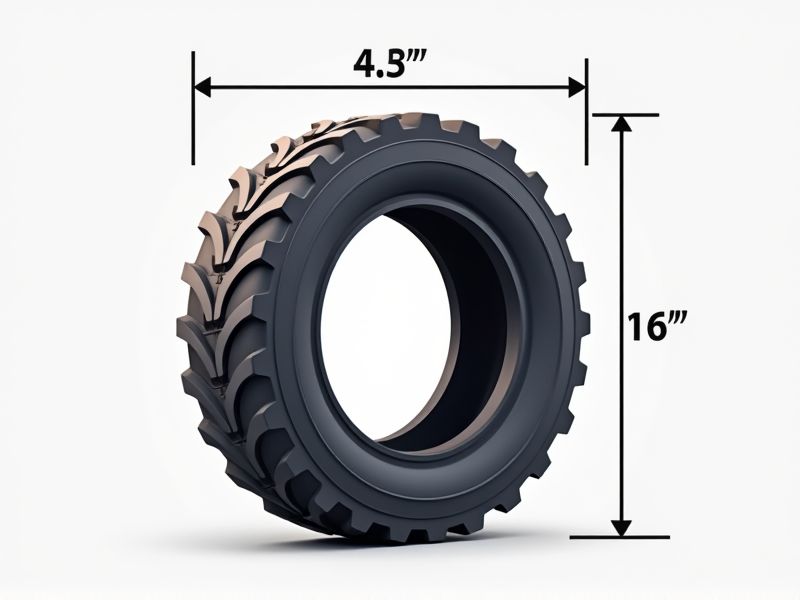
Standard tire dimensions are typically represented using a combination of numbers and letters--such as 205/55R16. The first number (205) indicates the tire's width in millimeters, while the second number (55) refers to the aspect ratio or profile height as a percentage of the width. The "R" stands for radial construction, and the final number (16) denotes the diameter of the wheel, in inches, that the tire fits. For example, a 205/55R16 tire is 205mm wide, with a sidewall height of 112.75mm (55% of 205), and fits a 16-inch wheel, offering a balanced option for many passenger vehicles.
Tire Width
Tire width significantly impacts vehicle performance and handling characteristics. A standard tire typically ranges from 155 mm to 285 mm in width, with wider tires often providing better traction and stability. For instance, a 205 mm tire enhances cornering grip while reducing braking distance. When selecting tires for your vehicle, consider how the width affects not just performance but also fuel efficiency and ride comfort.
Aspect Ratio
The aspect ratio of a standard tire is defined as the height of the tire's sidewall expressed as a percentage of its width. For example, a tire with an aspect ratio of 60 means the sidewall height is 60% of the tire's width. This measurement directly impacts handling, ride comfort, and overall vehicle performance. A lower aspect ratio typically provides better stability during cornering, while a higher ratio enhances cushioning and ride quality.
Diameter Of The Wheel
The standard measurement for tire diameter is crucial for optimizing vehicle performance and safety. Typically, tire diameters range from 13 inches to 22 inches, impacting acceleration, handling, and fuel efficiency. For example, a larger diameter tire can enhance stability and cornering grip, but may also affect ride comfort. When selecting tires, ensure that the diameter aligns with your vehicle's specifications for the best driving experience.
Load Index
The load index of a tire, typically ranging from 70 to 130, indicates the maximum load a tire can carry when properly inflated. For example, a tire with a load index of 95 can support up to 1,521 pounds at optimal pressure. This measurement is crucial for ensuring safety and performance, as exceeding the load capacity can lead to tire failure or compromised vehicle handling. When selecting standard tires, always check the load index to match it with your vehicle's requirements for reliable functionality.
Speed Rating
A tire's speed rating indicates the maximum speed at which it can safely operate, essential for optimal performance. Ratings typically range from A1 (up to 3 km/h) to Y (up to 300 km/h), with each letter representing a specific speed threshold. For standard tires, common speed ratings include S (up to 180 km/h), T (up to 190 km/h), and H (up to 210 km/h), ensuring drivers can select appropriate tires based on their driving habits. Always check your vehicle's specifications to match the tire speed rating with your needs for safety and performance.
Construction Type
The standard tire for construction equipment is typically designed with a heavy-duty construction type, ensuring durability and resilience under rigorous working conditions. These tires often feature deep treads that enhance traction on various surfaces, including gravel, mud, and asphalt, crucial for maintaining stability and control. A standard construction tire may also have a load capacity ranging from 3,000 to 10,000 pounds, depending on the equipment's specifications. Using the right construction tire can significantly impact operational efficiency and safety on job sites.
Section Width
The standard for tire sizing emphasizes section width, measured in millimeters, which significantly affects vehicle handling and stability. For example, a wider section width, such as 255 mm, provides improved grip and traction, especially during cornering. Tire performance can also be impacted by the aspect ratio, which represents the height of the tire's sidewall as a percentage of the section width. Selecting the right section width for your vehicle not only enhances driving experience but also ensures optimal safety and performance.
Overall Diameter
The overall diameter of a standard tire plays a critical role in vehicle performance, influencing factors such as speed, handling, and fuel efficiency. Typically measured in inches, the overall diameter can range from 14 to 30 inches, depending on the tire class and intended vehicle application. For instance, a larger tire diameter may enhance off-road capability and ground clearance, while smaller diameters can improve agility and enhance cornering stability. Choosing the right overall diameter ensures optimal vehicle dynamics and maximizes your driving experience.
Rim Diameter
The standard tire specification commonly emphasizes rim diameter, which directly influences vehicle performance and safety. For example, a typical passenger car may require a rim diameter ranging from 14 to 18 inches, affecting handling and ride quality. Choosing the correct rim diameter ensures optimal tire fitment, improving traction and reducing the risk of tire blowouts. When selecting tires, prioritize compatibility with your vehicle's specified rim diameter to enhance driving stability and efficiency.
Tread Depth
Tread depth is a critical factor in assessing the performance and safety of standard tires, with a minimum legal requirement of 1.6 millimeters in many regions. Optimal tread depth enhances traction, particularly in wet conditions, where deeper grooves can effectively channel water away from the tire surface, reducing the risk of hydroplaning. Regularly monitoring your tire tread depth can improve fuel efficiency, as worn tires create more rolling resistance, potentially increasing fuel consumption by 10% or more. Investing in proper tread depth maintenance extends tire lifespan, ensures better grip, and promotes overall vehicle safety.
